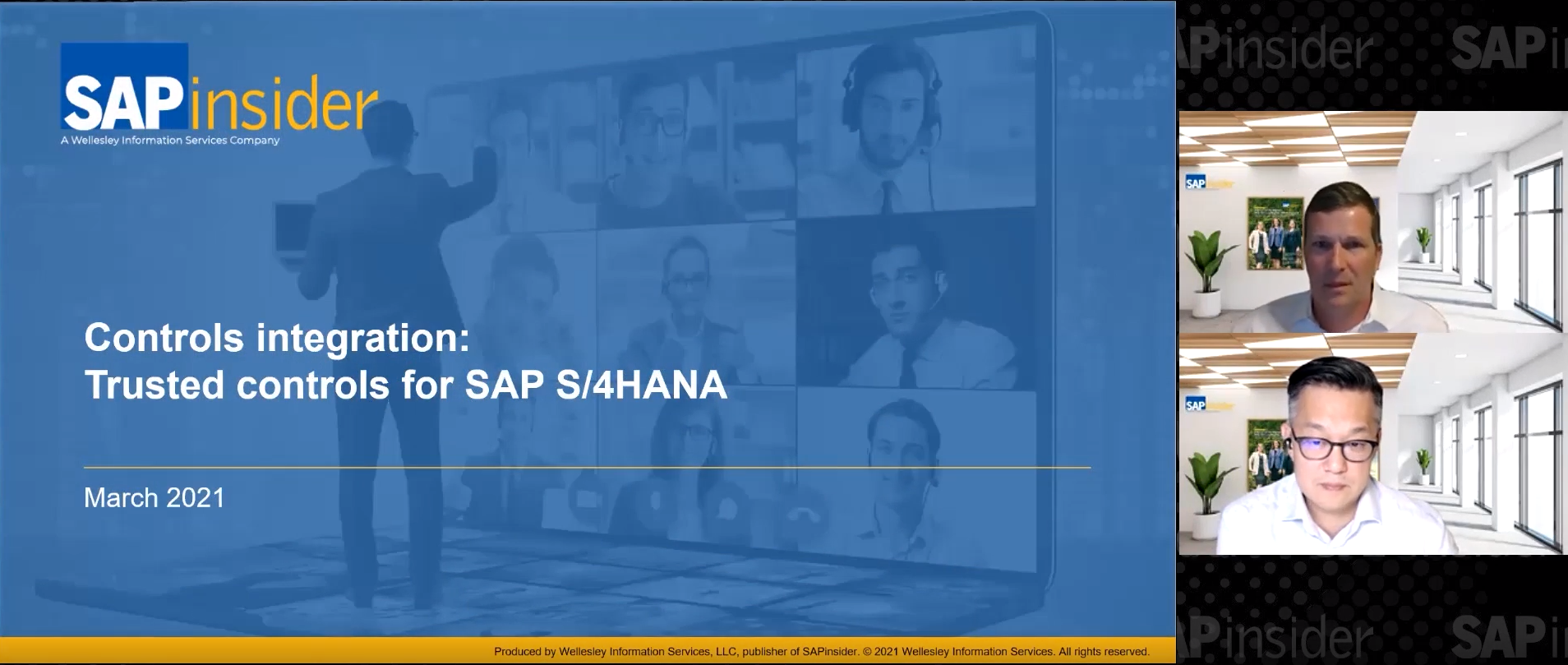Live from SAPinsider Studio: Birgit Starmanns of SAP on SAP S/4HANA
Birgit Starmanns, SAP, Senior Director, Product Marketing, SAP S/4HANA, joins SAPinsider Studio at the Financials 2016 event in Las Vegas to discuss SAP S/4HANA, touching on Universal Journal, Central Finance, cloud vs. on-premise, and SAP S/4HANA Enterprise Management (the 1511 update) which broadens supported functionality beyond financials.
This is an edited transcript of the discussion:
Ken Murphy, SAPinsider: Hi this is Ken Murphy with SAPinsider, and I’m at the SAPinsider Financials 2016 event in Las Vegas. Today, I am pleased to be joined by Birgit Starmanns, who is the Senior Director, Product Marketing, SAP S/4HANA. She is here today to talk to us a little bit about S/4HANA. Birgit, thanks for joining us.
Explore related questions
Birgit Starmanns, SAP: Thank you Ken for having me.
Ken: Birgit, can you highlight why SAP S/4HANA plays such a pivotal role in the digitization of the enterprise as that digital core?
Birgit: With S/4HANA it’s very important to look at the core processes, and then we also have some pillars that go around it. So core processes within the digital core – finance is really the linchpin of the first development where we really optimized S/4HANA for the in-memory technology. We’re doing that with other areas now as well such as manufacturing and supply chain, but finance was really the first to really optimize and change the underlying structure of how the processes are actually programmed. We also have out-of-the-box integration into other areas, so thinking about workforce such as SAP SuccessFactors, thinking about supplier networks which includes SAP Ariba, also looking at assets in the Internet of Things and really looking at futuristic scenarios of embedding chips and having those drive business processes such as proactive plant maintenance, and then also the whole marketing with SAP hybris. So we have built in those integration points already, but it’s really the core and if you look at the customers that are here at the Financials insider (event), it’s really that core that they’re interested in. And really optimizing and not just saying that they’re running the Business Suite on SAP HANA, but really leveraging in-memory technology and really changing the way that finance does business from being able to access information immediately, not having to wait for batch processes.
Ken: So the digital core is what advances S/4HANA from Suite on HANA? With that in mind, how does a company then identify use cases and build a business case for S/4HANA especially for that company that maybe is running Suite on HANA?
Birgit: I would say that Finance is really looking to transform the way they do business. And so looking at some of the scenarios that are now available with S/4HANA, whether it’s integration to those other hybrid areas that I talked about or whether it’s really changing the way that they do business so they can become a more strategic partner to the business. So if you look at some of the changes that we have; we have something called the Universal Journal, so what that means is that we’ve combined FI and CO information into one table, and that’s the Universal Journal. So that means we no longer have that separation and Finance can get that information immediately. As an example, instead of just looking at the Accounts Receivable account, then having to go somewhere else to get the customer number, all of that information is now in the Universal Journal. Also by combining the FI and CO into one place, we can also get financial information as well as controlling and managerial accounting information in the same reports. So looking at combining financial information as well as cost center information, profit center information, it’s all there. The other thing is the ability to have the same information for transactions and analytics. So basically because we have everything within the Universal Journal, Finance is using the same information for transactions as well as for analytics. So no more waiting for batch processes; we’ve also built some great dashboards with SAP Fiori so Finance can immediately see where there might be some issues in their process. So as they’re building the business case looking where they can improve their own organizations and create efficiencies, less reconciliation is needed, but is also creating more insight. So those are really the areas I would suggest looking at.
We also have a scenario called Central Journal; a lot of companies have multiple back-ends. But instead of having to convert all the multiple back-ends, you can have a scenario where you put up one S/4HANA and then connect all the back-ends to S/4HANA and do all your financial processing there. And that’s a very popular scenario especially from what we’ve been hearing at this conference.
Ken: From a process standpoint, what are some of the key changes a business has to make to get to that state of instant insight?
Birgit: Finance really needs to look at what they’re doing right now in terms of processing. Right now they’re waiting for a lot of batch processes and period end. So they just don’t have the information that they necessarily need. So looking at a business process perspective, what normally has to happen for example for the financial close? What are the different activities that happen? When do they take place and what order do they take place? And if we no longer rely on batch processes just at period end but being able to run them pretty much every day if that’s what a customer wants to do then you can really gain more efficiency. And then also looking at where can finance really help for example operations, and the CFO, CEO make better decisions? So really looking at how much time they’re spending doing reconciliations and manual work, getting rid of that and looking at being able to advise the business. So as an example, mergers and acquisitions. Looking at the financial implications of do we acquire Company A, Company B, do we create our own product, what are the financial implications of that? So finance can spend more time actually modeling, so the things that they always wanted to do but probably never had the time to because a lot of the processes were manual in spite of having a system, but there’s still a lot of reconciliation that used to be involved which is no longer the case.
Ken: A deployment questions. When does it make sense to deploy S/4HANA in the cloud vs. on-premise and what kinds of questions are you hearing from customers about that decision?
Birgit: We had a full session on that yesterday and it was interesting because two years ago we had a cloud session and barely had a dozen people. This time we had standing room only.
Ken: Progress.
Birgit: Definitely. I think Finance is becoming more comfortable with the technology with putting things in the cloud. They were always a little bit hesitant. Finance is getting more comfortable with putting processes in the cloud; I’d still say there are a lot of customers that are looking more at the hybrid scenarios. So maybe integrating an Ariba for invoice management, integrating that or maybe something like a Concur for travel and expense management. One scenario that we hear a lot is that if you’re purely in the cloud maybe for a subsidiary because if a customer has done a lot of say modifications in their on-premise system but maybe a subsidiary of somebody that they just purchased – being able to integrate those. So we’re seeing a lot of those hybrid scenarios. But we are seeing some customers start to look at maybe they do want to move their on-premise into the cloud – and (SAP) has both the Enterprise Edition and the public sector Professional Services Edition which doesn’t have the manufacturing but does have full financials as well as project management and budgeting. So really looking at the processes that are in place today. But there’s definitely more comfort level right now for Finance to be looking at cloud. I think very few customers are ready to say “I’m going from on-premise and I’m going to put everything into the cloud immediately.” I think they’re still looking at hybrid in order to get there, but there have been customers that are seriously considering it because then they don’t have to do upgrades on a regular basis, SAP does that for you.
Ken: Last year we spoke at this event and back then S/4HANA Finance was called Simple Finance. I was hoping you could address other than the name change – and from some of the things you’ve mentioned it seems there is more to added features and functionality (to S/4HANA) besides just the name change. Can you talk about that?
Birgit: Yes, it was a name change and we wanted it to be more consistent with all of S/4HANA; and we essentially have 10 lines of business, so everything from Finance, HR, sourcing and procurement, various logistics processes – manufacturing, supply chain, R&D, asset management – and then of course marketing, commerce, sales, and service. So really having those linkages and integration points is one of the big selling factors going back to your first question about the digital core. And then the new capabilities that we discussed things like Universal Journal, Central Finance, role-based Fiori apps; so I’d say there is definitely great interest and we continue to innovate with that and right now we’re also innovating as I mentioned with manufacturing as well. So I think there are a lot of new capabilities and customers are very interested. Last year they were saying, “What is this thing?” and last year we talked a little bit about the scope of encompassing all of finance and not just the innovations. This year we’re getting very detailed questions about how to migrate. So I think customers are really embracing the concept which is great to see.
Ken: Well maybe you can join us next year and we’ll see what the questions are then?
Birgit: Definitely. Looking forward to it.
Ken: Birgit, thanks for being with us today.
Birgit: Thanks Ken.








